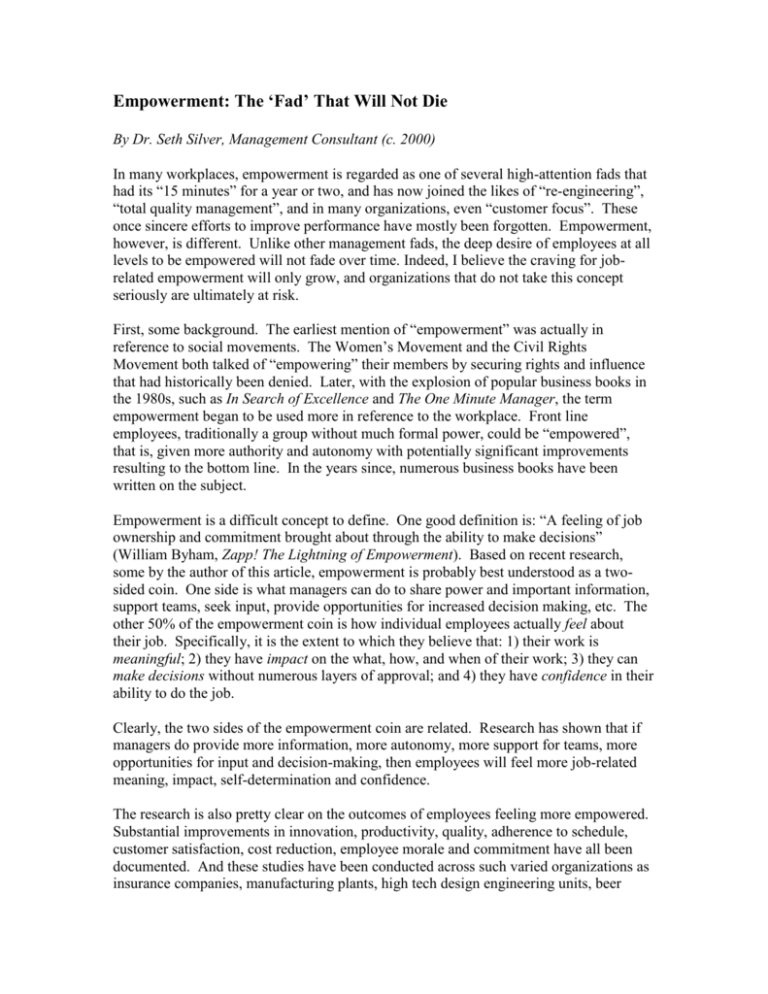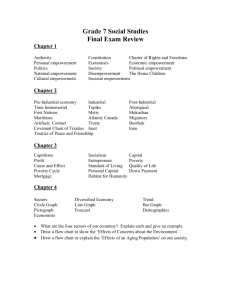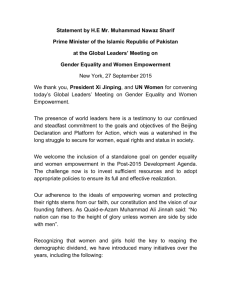Empowerment: The 'Fad' That Will Not Die
advertisement

Empowerment: The ‘Fad’ That Will Not Die By Dr. Seth Silver, Management Consultant (c. 2000) In many workplaces, empowerment is regarded as one of several high-attention fads that had its “15 minutes” for a year or two, and has now joined the likes of “re-engineering”, “total quality management”, and in many organizations, even “customer focus”. These once sincere efforts to improve performance have mostly been forgotten. Empowerment, however, is different. Unlike other management fads, the deep desire of employees at all levels to be empowered will not fade over time. Indeed, I believe the craving for jobrelated empowerment will only grow, and organizations that do not take this concept seriously are ultimately at risk. First, some background. The earliest mention of “empowerment” was actually in reference to social movements. The Women’s Movement and the Civil Rights Movement both talked of “empowering” their members by securing rights and influence that had historically been denied. Later, with the explosion of popular business books in the 1980s, such as In Search of Excellence and The One Minute Manager, the term empowerment began to be used more in reference to the workplace. Front line employees, traditionally a group without much formal power, could be “empowered”, that is, given more authority and autonomy with potentially significant improvements resulting to the bottom line. In the years since, numerous business books have been written on the subject. Empowerment is a difficult concept to define. One good definition is: “A feeling of job ownership and commitment brought about through the ability to make decisions” (William Byham, Zapp! The Lightning of Empowerment). Based on recent research, some by the author of this article, empowerment is probably best understood as a twosided coin. One side is what managers can do to share power and important information, support teams, seek input, provide opportunities for increased decision making, etc. The other 50% of the empowerment coin is how individual employees actually feel about their job. Specifically, it is the extent to which they believe that: 1) their work is meaningful; 2) they have impact on the what, how, and when of their work; 3) they can make decisions without numerous layers of approval; and 4) they have confidence in their ability to do the job. Clearly, the two sides of the empowerment coin are related. Research has shown that if managers do provide more information, more autonomy, more support for teams, more opportunities for input and decision-making, then employees will feel more job-related meaning, impact, self-determination and confidence. The research is also pretty clear on the outcomes of employees feeling more empowered. Substantial improvements in innovation, productivity, quality, adherence to schedule, customer satisfaction, cost reduction, employee morale and commitment have all been documented. And these studies have been conducted across such varied organizations as insurance companies, manufacturing plants, high tech design engineering units, beer distributorships, health clubs, airlines, etc. So, while there will always be some people who doubt and resist empowerment, there really is no longer any credible argument against the positive relationship between empowerment and performance. So, why is empowerment different from the other ‘fads’ of the last 20 years, and why will it become more important over time? First, people will always desire the right to influence what happens to them. In contrast to other management initiatives, in which employees may or may not actually want to use Quality tools, re-design their work processes, or plan their work around their customer’s needs, empowerment allows workers to have control over their jobs, use their own judgment, make relatively independent decisions, and not be told excessively what, when, or how to do things. Our desire for job-related empowerment is essentially an extension of our natural psychological need for self-control and autonomy. Consider the inverse: who would enjoy a job where you are micro-managed, have little or no permission to make relevant decisions, where your opinion is disregarded, and where what you are doing is considered essentially unimportant and expendable? The second reason that empowerment will become more important is that the younger generations of workers, sometimes referred to as Generation X (born after 1965) and Generation Y (born after 1980), expect it. Their attitude toward work presumes that respect, the opportunity to have impact, and a degree of personal meaningfulness are prerequisites to even applying for a job. If these workers feel they are being treated as expendable and that their input is not valued, they will leave. And in today’s economy, recent turbulence aside, recruiting and keeping talent is vital to being competitive and high turnover can be lethal. Finally, empowerment will remain important because smart managers know it is one of the surest means to improve performance and morale. The data, frankly, is mixed on the long-term benefits of re-engineering, process re-design, even the implementation of Total Quality Management. It is not mixed on empowerment. Organizations that are serious about improving their bottom line will, sooner or later, have to consider the benefits of sharing power, really listening to employees, and allowing them to make more decisions about both their jobs and the course of the organization. As noted, there are many books on the manager’s role in creating the empowered workplace. Here are six key practices that will lead to improvement on both sides of the empowerment coin. Consider these a checklist to discuss with your team or organization, and based on the feedback, use them as starting points to re-energize your efforts on workplace empowerment: 1. Share lots of information, with all levels in the organization. This includes information on group performance, expenses, comparisons with the competition, customer feedback, future trends and plans, etc. This helps people to feel more like partners and less like ‘employees’. It communicates trust and says “we’re all in this together”. 2. Set clear boundaries. This essentially means being clear on the policies and processes people need to follow, the acceptable limits of individual and team authority, and the priority of respective goals. If these goals, boundaries and decision limits are well understood, people will actually become more selfdirecting and less reliant on management. 3. Support the use of self-managing teams. Where possible, consider whole projects and tasks that can be delegated to teams, including some of your own work. Make the teams responsible for defining goals, key processes, resources and measures of success, and ensure that they are clear on their boundaries (spending, timeframes, etc.). 4. Don’t try to control things. If you empower a team or an individual, they may come up with an approach you would not have selected. Your integrity as a manager will rest on what you do. If you usurp their power, they will not soon trust you again (“Aha, we’re empowered only so long as we do what the boss would do”). If their solution or approach is intolerably wrong, you will need to coach them in such a way that they decide what to change. 5. Let people exercise their ‘decision muscles’. That is, give people as much choice, in as many areas, as possible. The more people exercise their capacity to make decisions, the ‘stronger’, i.e. more competent, confident, and empowered, they will become. 6. Your role is to coach. This means you must ensure people are clear about the goals; that they understand the Big Picture, and how what they do fits into it. You must ensure needed resources and support are available. And finally, you must provide constant feedback, both positive and constructive, and ask lots of questions to stimulate learning and to help people prepare for increased responsibility and autonomy. The 18th century German thinker, Goethe, captured the essence of empowerment in this statement: “Treat a man as he is, and he will remain as he is. Treat him as he can and should be, and he will become as he can and should be”.








